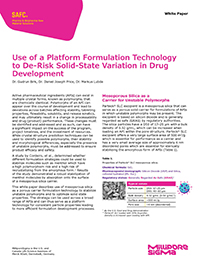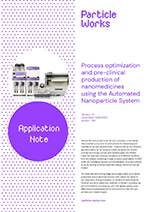Bio Platforms
2024 COMPANY PROFILES & CAPABILITIES
For each participating company, this section presents a detailed summary highlighting their core technologies, capabilities, technologies, and services.
CLOUD COMPUTING - Revolutionizing Antibody Discovery: The Role of Cloud Computing
Suhani Nagpal, PhD, Laura Spector, PhD, and Frank Erasmus, PhD, discuss the role of cloud computing in antibody discovery, its benefits, and its potential applications in the field of biotechnology.
EXECUTIVE INTERVIEW - Precision NanoSystems Inc. (part of Cytiva) & SCIEX: Lipid Impurities Within mRNA-LNPs
Kerstin Pohl, Senior Manager of Cell & Gene Therapy & Nucleic Acids at SCIEX, and Scott Ripley, General Manager of Nucleic Acid Therapeutics at Cytiva, dive into the detection of a new class of impurities within mRNA drugs and the impact it has on manufacturing.
LIPOSOMAL PEPTIDE THERAPEUTICS - Revolutionizing Oncology: Unleashing Innovative Strategies to Tackle Challenging, High-Value Drug Targets
Natalia Zisman, Krishna Allamneni, PhD, and Stacy W. Blain, PhD, explain how targeting downstream signaling proteins offers a promising approach to effectively mitigate the emergence of drug resistance that precision oncology therapies leave behind.
FORMULATION FORUM - CUBOSOMES – The Next Generation of Lipid Nanoparticles for Drug Delivery
Jim Huang, PhD, and Shaukat Ali, PhD, shed light on the design and formation of cubosomes with special focus on their applications for delivery of hydrophobic and hydrophilic small and large molecules, including oncology drugs and polynucleotides (DNA, mRNA, and siRNA).
PLATFORM TECHNOLOGY - The PTXΔLNP® Platform: On the Promise of Developing New LNPs for Tomorrow’s mRNA Therapies
Charlotte Dunne, PhD, Katrin Radloff, PhD, and Leonidas Gkionis, PhD, review the PTXΔLNP platform and how it offers a synergistic sister technology to the mRNA platform to obtain potent mRNA-LNPs for therapeutic applications.
BIOLOGICS DEVELOPMENT - Five Steps to a Robust Cell Line Development Process
Robert Gustines reviews the critical steps for designing and implementing a robust cell line development process to help overcome the obstacles that often hinder biologic production.
CELL & GENE THERAPY - Cell & Gene Therapy’s Everest – The Challenges & Opportunities That Will Shape Success
Samir Acharya, PhD, Rajiv Vaidya, PhD, Laura Kerepesi, PhD, and Cyrill Kellerhals, MBA, provide their unique insights as they explore the challenges cell and gene therapy developers and manufacturers are currently facing, those they can expect to see in the future, and more critically, how to overcome them.
THERAPEUTIC FOCUS - Effect of NE3107 on the Pharmacokinetics Profile of Carbidopa/Levodopa in Patients With Parkinson’s Disease
Joseph M. Palumbo, MD, says addressing Parkinson’s via the inflammatory pathway offers a unique perspective that was virtually unheard of only 10 years ago.
WHITEPAPER - Use of a Platform Formulation Technology to De-Risk Solid-State Variation in Drug Development
This white paper describes use of mesoporous silica as a porous carrier formulation technology to stabilize unstable polymorphs and to optimize solid state properties.
EXCLUSIVE ONLINE CONTENT

Evaxion Announces Phase 2 Clinical Trial Update: First Patient Completed Dosing With Personalized Cancer Vaccine
Significant Phase 2 clinical trial progress obtained with first patient finalizing EVX-01 vaccine dosing….

Voyager Therapeutics Announces Selection of Development Candidate for GBA1 Program in Collaboration With Neurocrine Biosciences, Triggering Milestone Payment
Voyager Therapeutics, Inc. recently announced the joint steering committee with its collaborator Neurocrine Biosciences has selected a lead development candidate in the GBA1 gene therapy program for the potential treatment of Parkinson’s disease….

Kincell Bio & Imugene Announce Strategic Manufacturing & Process Development Partnership
Kincell Bio to acquire Imugene’s North Carolina manufacturing facility for up to $6M USD in upfront and milestone-driven payments over 3 years….

Cullinan Therapeutics Announces Strategic Expansion Into Autoimmune Diseases & $280-Million Private Placement
CLN-978 clinical development to focus exclusively on autoimmune diseases, pursuing systemic lupus erythematosus as a first indication….
BC Platforms & NTT Group Announce Official Opening Ceremony for Exclusive Collaboration & Launch of Japanese Precision Medicine Platform
BC Platforms (BCP) recently announces an exclusive collaboration with NTT Life Science Corporation, a company in the medical field of the NTT Group, to accelerate data-driven….
MARKET NEWS & TRENDS
WEBINARS

On-Demand Webinar: How to Safely Handle Your Antibody Drug Conjugate
Antibody Drug Conjugates (ADCs) have a highly specific mechanism of action which is an advantage for the treatment of several oncology indications…..
WHITE PAPERS

WHITEPAPER - Use of a Platform Formulation Technology to De-Risk Solid-State Variation in Drug Development
This white paper describes use of mesoporous silica as a porous carrier formulation technology to stabilize unstable polymorphs and to optimize solid state properties.

WHITEPAPER - Long-Acting Injectable Nanoparticle Formulations
Long acting injectable (LAI) formulations have been the subject of continued interest in the recent past due, in part, to their longer systemic circulation requiring less frequent dosing of drugs.

WHITEPAPER - PLGA Nanoparticles - Bridging the Gap From R&D to GMP
Poly(lactic-co-glycolic acid) (PLGA) has emerged as a promising material for drug delivery and biomedical applications. Its exceptional biocompatibility, customizable degradation and release properties, and versatility have led to….

APPLICATION NOTE: Process Optimization & Preclinical Production Using the ANP System
Particle Works is thrilled to announce the launch of a new Application Note that delves into the advancement of nanoparticles as carriers for targeted drug delivery. Developing nanoparticles for this purpose can be….

WHITEPAPER - Improve Process Economics & Enable High Protein Concentrations
What if you could achieve higher protein concentrations during downstream processing? This whitepaper spotlights how excipient combinations can enhance manufacturability and final concentration of mAb formulations.
What are Bio Platforms?
Platforms (or asset-independent technologies to capture all kinds of capabilities that can be leveraged across many different drug candidate assets rather than just discovery tools that the term ‘platform’ immediately brings to mind) are ubiquitous in modern pharma. They are the product of an arms race, to secure access to the best capabilities in key areas.
Platform technologies are considered a valuable tool to improve efficiency and quality in drug product development. The basic idea is that a platform, in combination with a risk-based approach, is the most systematic method to leverage prior knowledge for a given new molecule. Furthermore, such a platform enables a continuous improvement by adding data for every new molecule developed by this approach, increasing the robustness of the platform.
But it has often been said that access to the latest technological platforms to aid efficient drug discovery and development is limited to Big Pharma, which can more easily justify the costs of creating and operating these platforms.
Benefits of Bio Platforms
Platform technologies have the ability to radically improve upon current products and generate completely novel products. In this sense, they open up new arenas for drug discovery and development, potentially increasing the number of therapeutic options for patients. Once a single compound or therapeutic has been generated and demonstrates a clinical benefit in patients, it is more likely this platform technology can successfully be applied to other therapeutic areas, derisking future compounds/products.
Complex drugs by their very nature are challenging and costly to manufacture. This, in turn, translates into higher costs for patients and other payers. In order to provide safe and effective therapies at a reasonable price, it is necessary for the industry to develop manufacturing technologies that reduce costs and provide a consistent product. While the initial investment may be larger, manufacturing costs will be lower over time as the manufacturing process is solidified.
Scale and Investment of Bio Platforms
Despite the initial upfront costs, platform technologies inevitably provide pragmatic solutions to production challenges, while yielding safer and more effective therapeutic products. It has often been said that one of the key features that distinguishes “Big Pharma” from biotech is access to the latest technological platforms to aid efficient drug discovery and development.
These platforms range from vast chemical libraries, ultra-high throughput screening and huge genetic databases in discovery, to predictive toxicology platforms, cutting-edge ‘omics’ and even deep-seated knowledge of particular therapeutic areas in development. All these platforms have two things in common: They can be used on any (or many) development candidate assets, and they cost huge sums to establish in the first place, and in a few cases each time they are used as well. Hence their restriction to the largest pharmaceutical companies (and a few of the so-called “big biotechs” that are, in many ways, indistinguishable from the old-guard pharma).
Only when you have hundreds of active projects can you justify the cost of creating and operating these platforms. Or so the mantra goes. It is access to these platforms that keeps the big companies ahead in the race to discover and develop the best medicines (or at least counterbalance the disadvantages of being large and slow-moving, depending on your point of view). But is that just an assertion? How much evidence is there to support the proposition that the efficiency gains due to these platforms outstrips the cost of creating and maintaining them?
Keeping these technologies “cutting edge” has become so expensive that increasingly we hear pharma companies talking of “pre-competitive” approaches to develop the next generation. A group of companies might develop a platform capability they then share. The principle goal of such initiatives is to access even grander and more expensive tools than individual companies could afford, rather than to dramatically cut costs (although sharing platforms rather than developing the same thing in parallel in each silo should at least keep a lid on rising costs).






